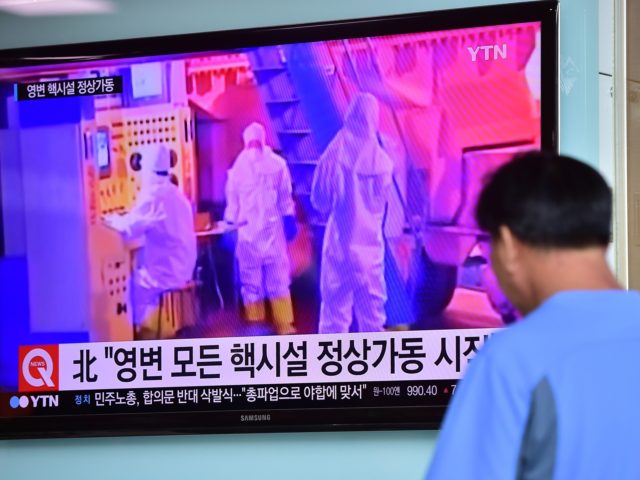The North Korea monitor website 38 North published satellite images on Tuesday that indicate uranium enrichment activity continues at the communist regime’s Yongbyon Nuclear Scientific Research Center, one of the top facilities for the generation of nuclear fuel.
The website published its new images, which analysts noted seemed to show “continued enrichment operations,” on the same day that North Korean state media published a speech by communist dictator Kim Jong-un in which he asserted that the illegal possession of nuclear weapons was responsible for the end of active hostilities in the Korean War, and would ensure long-term peace.
The Korean War remains currently in vigor, turning 70 years old this year, as none of the participants have signed a peace treaty. An armistice agreement between the two Koreas and their allies, China and America, resulted in the end of active fighting in 1953.
“Commercial satellite imagery over the past year indicates that the light activity observed throughout North Korea’s Yongbyon Nuclear Scientific Research Center goes beyond a caretaker status,” 38North observed on Tuesday. “Caretaker” operations would result in the facility only being kept ready for immediate use rather than actively generating enriched uranium and such a status would show a potential desire on the part of the regime to come to an agreement with the international community to end its illegal nuclear weapons development. Instead, the satellite images appear to show that North Korea is actively generating fissile material that can be used to build a bomb.
The analysis centered around the recent appearance and disappearance in the images of railcars, indicating they are traveling to the facility, engaging in some activity, and leaving repeatedly.
“Their presence at Yongbyon is cyclical, arriving every few months, three to four times a year, and remaining for a couple of weeks at a time,” 38 North noted. “This pattern suggests some type of ongoing operation within these facilities, which requires the removal or receipt of some unidentified chemical agent.”
Relatedly, the site spotted what it noted could be a tanker carrying liquid nitrogen in images from the past month.
“In addition to the specialized railcars, a possible LN tanker trailer has appeared at the far west end of the UEP at irregular intervals, most recently arriving sometime between July 11 and 14. Liquid nitrogen is necessary for operating cold traps in the uranium enrichment process and running vacuum pumps,” the website stated. “Replenishment of the LN would be necessary to maintain continued centrifuge operations.”
The article concluded that the nuclear activity at the site was minimal compared to its potential, noting that “there has been no evidence to suggest either the 5 MWe Reactor or the Experimental Light Water Reactor (ELWR) have been operating.”
Kim Jong-un signed an agreement with President Donald Trump in Singapore in 2018 where he agreed to a “commitment to complete denuclearization.” North Korea has consistently defined “denuclearization,” however, not as the conclusion of its own nuclear development, but as the removal of all American assets from the Korean peninsula, arguing that America is a nuclear power and so any Ameican soldiers on Korean territory represent a nuclear presence. The Trump administration’s top diplomat on Korea, Stephen Biegun, admitted last year that Pyongyang and Washington did not agree on a “specific” definition of the word “denuclearization.”
Kim made clear his commitment to North Korea’s nuclear program in a speech Monday to veterans of the Korean War, known in North Korea as the “Fatherland Liberation War.”
“War is an armed clash which can be unleashed only against a weak one,” Kim told the veterans. “None can now make little of us. We will not allow others to look down upon us and, if they do so, make them pay dearly.”
“Thanks to our reliable and effective self-defense nuclear deterrence, the word war would no longer exist on this land, and the security and future of our state will be guaranteed for ever,” the dictator asserted.
Little evidence exists that, even following the 2018 summit with Trump, North Korea ever shut down the Yongbyon nuclear facility. Satellite image monitoring by 38 North found evidence for enrichment throughout 2019.
“It looks pretty much like it’s looked for the last 10 or 15 years,” Jeffrey Lewis of the Middlebury Institute of International Studies said in February 2019, following the failed second summit between Trump and Kim in Hanoi, Vietnam. Trump walked out of the summit, he said, because North Korean diplomats were too intransigent in demanding sanctions relief in exchange for too few concessions.
“Basically, they wanted the sanctions lifted in their entirety and we couldn’t do that,” Trump said.
North Korean Foreign Minister Ri Yong-ho refuted Trump’s claims, alleging that his country had offered to shut down the Yongbyon facility in exchange for sanctions relief following Trump’s departure. Trump had stated previously, however, that shutting down Yongbyon alone would not guarantee an end to the nuclear weapons program and that his administration had demanded nothing short of complete denuclearization in exchange for any sanctions relief.

COMMENTS
Please let us know if you're having issues with commenting.